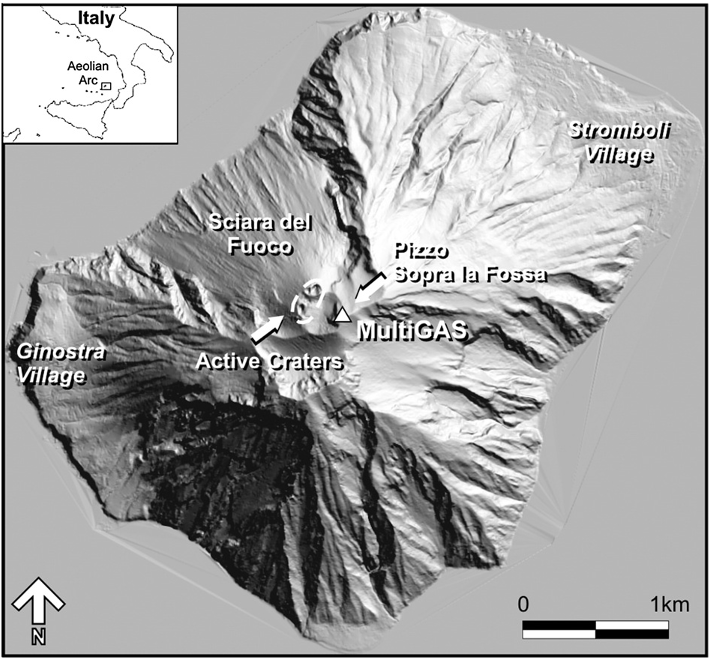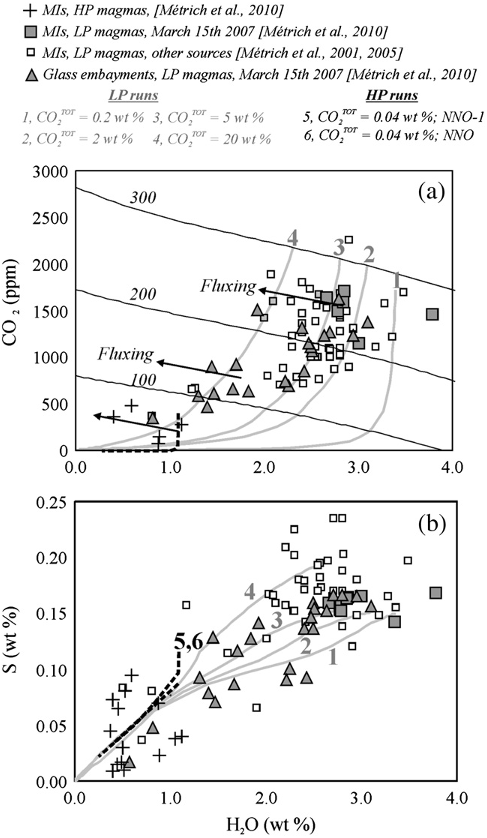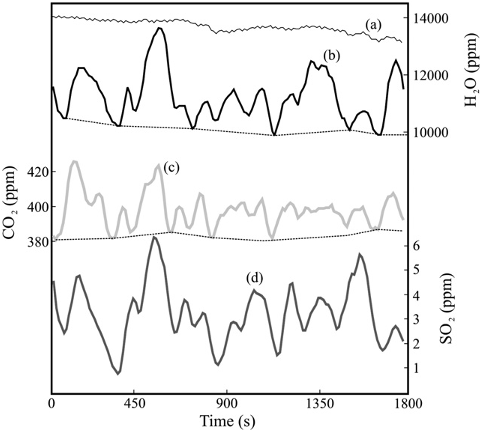A model of degassing for Stromboli volcano
Alessandro Aiuppa,Antonella Bertagnini,Nicole Métrich,Roberto Moretti,A. Di Muro,Marco Liuzzo,Giancarlo Tamburello +6 more
TLDR
In this article, the authors used the MultiGAS technique to provide the best documented record of gas plume discharges from Stromboli volcano to date, and showed that Strombolian's gases are dominated by H2O (48−98−mol); mean, 80%), and by CO2 (2−50−mol%; mean, 17%) and SO2 (0.2−14−mol; mean, 3%).About:
This article is published in Earth and Planetary Science Letters.The article was published on 2010-06-15 and is currently open access. It has received 144 citations till now. The article focuses on the topics: Strombolian eruption & Volcanic Gases.read more
Figures

Fig. 6. Schematic cross-section showing the main features of Stromboli's crustal plumbing system (modified from Métrich et al., 2010). See text for discussion. 
Fig. 1. A map of Stromboli showing the location of the permanent MultiGAS on Pizzo Sopra la Fossa. 
Fig. 7. Volatile abundances in Stromboli's melt inclusions and glass embayments contrasted against results of the saturation model. Data fromMétrich et al. (2001, 2005, 2009) and Bertagnini et al. (2003). (a) H2O vs. CO2; (b) H2O vs. S. The grey solid lines are model results from LP runs 1–4, whilst black dashed lines show model results from HP runs 5–6. Comparison of natural and modelled compositions confirms that the deep (PN100 MPa) LP magma contains a high (2–5 wt.%; model curves 2–3) fraction of gas bubbles at reservoir conditions. Glass embayment formed at P∼100 MPa are H2Opoorer than predicted by model curves 2–3, suggesting some extent of gas fluxing with CO2-rich gas bubbles. This triggers de-hydratation of the LP magma, and probably controls transition to HP magma. The same process likely occurs also in the upper conduit system (compare model trends 5–6 with volatile abundances in HP magmas). In a, isobars are traced under a fixed Fe2/Fetot ratio of 0.24 (Table 2), and are thus slightly different than those originally reported byMétrich et al. (2010) (who, yet using the same saturation model, used a constant ΔNNO value, thus yielding variable Fe2/Fe3 proportions depending on melt composition, and water particularly). 
Table 1 Compositions of Stromboli's volcanic gas plume (in mol%). We derive compositions for both the bulk plume (essentially contributed by persistent passive degassing) and the syn-explosive plume (the gas jet of a Strombolian explosion, reaching the MultiGAS a few seconds after the burst, and before being diluted in the main plume). 
Fig. 2. An example of a 1800 sMultiGAS acquisition at Stromboli (acquisition frequency, 9 s). Whilst small erratic variations of H2O concentrations are typically measured when the plume is condensing (curve a), more systematic variations (curve b) are observed in dry weather conditions and when the plume fumigates the Pizzo Sopra la Fossa area. These are correlated with variations of CO2 (curve c) and SO2 (curve d) concentrations. In such circumstances, volcanic H2O was derived from the raw data (b) by subtracting background air H2O content; this required fitting a polynomial function (shown as a dotted line) to H2O measurements for which a SO2 content of nearly 0 was consistently detected. 
Table 2 List of input parameters of model runs. LP runs simulate isothermal closed system ascent of LP magmas (melt composition data Métrich et al., 2010) within their storage zone (300– 190 MPa pressure range), and upon shallow emplacement (down to 100 MPa). Redox conditions along the decompression path were fixed by the Fe2+/Fe3+ buffer, for which we adopted the value of 3.4. This choice is based on XANES determinations on a hydrous (H2O=2.9 wt.%) LP magma melt inclusion (Bonnin-Mosbah et al., 2001), but is also consistent with the olivine-liquid iron and magnesium partition observed in a large set of Stromboli MIs (Bertagnini et al., 2003). The resulting logfO2 conditions range from 0.07 to 0.82 NNO (NNO is the Nickel–Nickel Oxide buffer). Note that while MI compositions can be taken as good proxies for total (exsolved+dissolved) water and sulphur contents (then evaluated as H2OTOT: 3.4 wt.%; STOT: 0.16 wt.%, respectively), LP magmas were probably already saturated with a CO2-rich gas phase when the most primitive MIs formed. If such, the highest measured dissolved CO2 content (∼0.2 wt.%; see Fig. 7a) in MIs would significantly underestimate CO2TOT. Four separate LP runs (with different CO2TOT contents; these should be viewed as CO2 concentrations in the magma, i.e., in the melt plus gas suspension) were thus carried out. As for HP runs, we considered a shoshonitic melt with total CO2, H2O, and S contents of 0.04, 1.2 and 0.1 wt.%, respectively (as from representative compositions of MIs in olivines from erupted HP products; Métrich et al., 2010). The recurrent observation of a sulphide immiscible liquid phase in MIs suggests that the HP magma is potentially in a more reducing redox state than the LP magma; we therefore performed model runs at both NNO at NNO-1 redox conditions. For both LP and HP runs, melt composition data are from Métrich et al. (2010).
Citations
More filters
Journal ArticleDOI
Mantle source heterogeneity for South Tyrrhenian magmas revealed by Pb isotopes and halogen contents of olivine-hosted melt inclusions
Estelle Rose-Koga,Estelle Rose-Koga,Estelle Rose-Koga,Kenneth T. Koga,Kenneth T. Koga,Kenneth T. Koga,Pierre Schiano,Pierre Schiano,Pierre Schiano,Marion Le Voyer,Nobumichi Shimizu,Martin J. Whitehouse,R. Clocchiatti +12 more
TL;DR: In this article, 19 olivine-hosted melt inclusions from seven volcanoes (Etna, Stromboli, Vulcano, Ustica, Alicudi, Marsili and Vavilov) from the southern Italy region were analyzed for abundances of major, trace, and volatile elements, along with Pb isotope ratios.
Journal ArticleDOI
Flank instability of Stromboli volcano (Aeolian Islands, Southern Italy): Integration of GB-InSAR and geomorphological observations
Emanuele Intrieri,Federico Di Traglia,Federico Di Traglia,Chiara Del Ventisette,Giovanni Gigli,Francesco Mugnai,Guido Luzi,Nicola Casagli +7 more
TL;DR: In this article, a long-term analysis of GB-InSAR data has been carried out to identify two landslides whose movements are strongly related with volcanic activity, and their position has been confirmed to confirm that the effusive vent formed in 2007 at 400m/a.s.l., was the result of the deflection of a feeder dike caused by landslide fractures.
Journal ArticleDOI
New clues on the contribution of Earth’s volcanism to the global mercury cycle
Emanuela Rita Bagnato,Alessandro Aiuppa,Francesco Parello,Patrick Allard,Hiroshi Shinohara,Marco Liuzzo,Gaetano Giudice +6 more
TL;DR: In this article, the authors estimate that the 7 active open-conduit volcanoes have Hg emission rates ranging from 0.2 to 18 t yr-1 (corresponding to a total Hg flux of ~41 t·yr-1).
Journal ArticleDOI
Deformations and slope instability on Stromboli volcano: Integration of GBInSAR data and analog modeling
TL;DR: In this paper, the results of analog experiments of slope instability and ground deformations, recorded by the GBInSAR system on the western flank of the Stromboli volcano during the period 2009-2011 have been analyzed.
Journal ArticleDOI
Radiative heat power at Stromboli volcano during 2000-2011: Twelve years of MODIS observations
Diego Coppola,Davide Piscopo,Marco Laiolo,Corrado Cigolini,Dario Delle Donne,Maurizio Ripepe +5 more
TL;DR: In this paper, the radiative heat power of Stromboli volcano has been analyzed using 12 years of night-time MODIS (Moderate Resolution Imaging Spectroradiometer) observations, using an accurate background subtraction of the MODIS signal at 4μm.
References
More filters
Journal ArticleDOI
The compositional dependence of the saturation surface of H2O + CO2 fluids in silicate melts
TL;DR: Papale et al. as mentioned in this paper applied thermodynamic equilibrium between gaseous and liquid volatile components to model the volatile saturation surface in H 2 O−CO 2 -silicate melt systems.
Journal ArticleDOI
Volatile Abundances in Basaltic Magmas and Their Degassing Paths Tracked by Melt Inclusions
Nicole Métrich,Paul J. Wallace +1 more
TL;DR: The abundances of CO2, H2O, S and halogens dissolved in basaltic magmas are strongly variable because their solubilities and ability to be fractionated in the vapor phase depend on several parameters such as pressure, temperature, melt composition and redox state as mentioned in this paper.
Journal ArticleDOI
Melt inclusion record of the conditions of ascent, degassing, and extrusion of volatile-rich alkali basalt during the powerful 2002 flank eruption of Mount Etna (Italy)
TL;DR: In this article, the authors decipher the origin and mechanisms of the second eruption from the composition and volatile (H2O, CO2, S, Cl) content of olivine-hosted melt inclusions in explosive products from its south flank vents.
Journal ArticleDOI
Petrologic Reconstruction of Magmatic System Variables and Processes
Jon D Blundy,Kathy Cashman +1 more
TL;DR: In this article, the authors present some of the current petrological techniques that can be used for studying eruptive products and for constraining key magmatic variables such as pressure, temperature, and volatile content.
Journal ArticleDOI
Magmatic Gas Composition Reveals the Source Depth of Slug-Driven Strombolian Explosive Activity
Mike Burton,Mike Burton,Mike Burton,Patrick Allard,Patrick Allard,Patrick Allard,F. Murè,F. Murè,F. Murè,Alessandro La Spina,Alessandro La Spina,Alessandro La Spina +11 more
TL;DR: Spectroscopic measurements performed during both quiescent degassing and explosions on Stromboli volcano are used to demonstrate that gas slugs originate from as deep as the volcano-crust interface (∼3 kilometers), where both structural discontinuities and differential bubble-rise speed can promote slug coalescence.